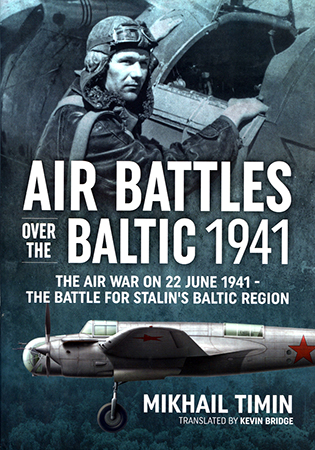
Air Battles over the Baltic 1941 Book Review
By David L. Veres
| Date of Review | November 2018 | Title | Air Battles over the Baltic 1941 |
|---|---|---|---|
| Author | Mikhail Timin | Publisher | Helion |
| Published | 2018 | ISBN | 9781911512561 |
| Format | 400 pages, hardbound | MSRP (USD) | $79.95 |
Review
Mikhail Timin intensely illumines Soviet military aviation at the very start of The Great Patriotic War in Air Battles over the Baltic 1941: The Air War on 22 June 1941 - The Battle for Stalin's Baltic Region from Helion and Company – available in North America from Casemate.
Methodically mining archival sources, Timin kick-starts contents with candid commentary on the Baltic Special Military District in 1940 – training, basing, equipment, facilities, production, and performance. Even capsule biographies of key personalities augment the effort.
Soviet Russia had finally defeated Finland in the Winter War. It occupied Latvia, Lithuania, and Estonia. And it conquered half of Poland.
Despite these gains, however, Stalin's forces in the area faced serious readiness problems. And Timin tallies these – issue-by-issue, warplane-by-warplane, unit-by-unit – in almost mind-numbing minutiae.
By 1941, obsolete aircraft still overwhelmingly dominated Baltic-based VVS formations. Polikarpov I-153 biplanes, for instance, substantially outnumbered every other fighter type. And transitions to more modern designs, often fraught with defects, proved particularly problematic.
New MiG-1 and MiG-3 interceptors, for instance, suffered armament, airframe, engine, and throttle troubles – reducing reliability, disrupting conversions, and, most critically, costing lives.
The experience and competency of pilots and support personnel played parts, too. Add questionable and inept command decisions – and irrational Soviet expansion schemes. And all kindled operational and organizational quandaries ahead of coming conflict with Nazi Germany.
Timin tracks Luftwaffe activities, too. And he devotes a substantial chapter to Hitler's preparations for Operation Barbarossa – and to Soviet status on the eve of invasion.
Coverage finally reaches combat about 230 pages into the account. And confusion reigned – as Timin's hour-by-hour combat chronicle of the first day's fighting naturally notes.
German aerial victory claims, for instance, unsurprisingly totaled twice that of actual Soviet air-to-air losses. And some Soviet airmen, strictly following earlier orders not to "provoke" Germany over peacetime Luftwaffe incursions, failed to fire on attacking Nazi aircraft. Worse, Soviet "military and political leadership" even refused to "undertake retaliatory strikes on German airbases".
Surprises abound. The "first aircraft shot down in the air battles in the skies over the Baltic region", the author avers, were two "DJ-6s". In fact, Timin's table of Luftwaffe air-to-air claims shows 11 "DJ-6" victories 22 June 1941.
But might Timin really mean the rather rare Kochyerigin DI-6Sh ground attack aircraft? Could these be transliteration errors, instead?
Hundreds of photos with extended, explanatory captions season the survey. Anecdotes, action accounts, maps, tables, and annotations further flavor text. And over 130 color profiles and inset details with commentary sample the savory smorgasbord of 1941 Soviet and German warplane warpaint. Multiple appendices and indices conclude contents.
Nevertheless, some gremlins stalk this otherwise excellent effort.
Watch for switched captions – and for minor caption identification errors. I think the translator meant "cowlings" or "nacelles", not "gondolas" – and "handling", not "pilotage". What are "split pilot cap" and "alignment in the first echelon"? And more substantively, why overtly avoid the rancid role of communist purges and politics in VVS readiness and performance?
Still – wow – what a densely detailed, amazingly informative account. Mikhail Timin's superb study deserves pride-of-place in every library of Eastern Front WWII aerial combat.
I absolutely loved it.
With thanks to Casemate Publishing for the review copy!







